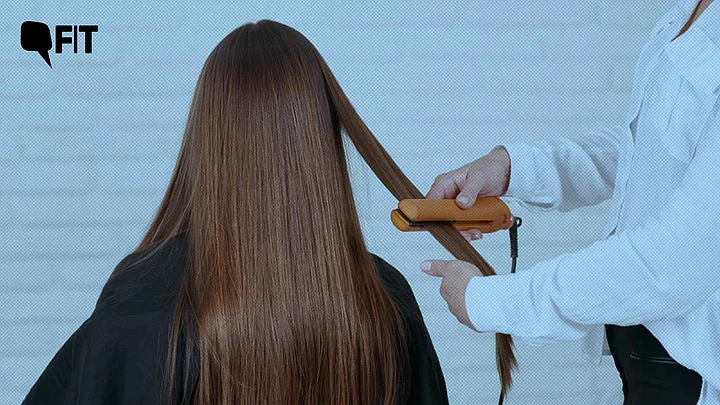Many women aspire to achieve silky-smooth straight hair and often turn to a variety of treatments and products like conditioners and straighteners. Among these, the keratin treatment stands out as a popular method, offering promises of frizz-free, smooth, and straight hair.
However, a recent incident where a woman suffered serious kidney injury and scalp burns after undergoing the treatment, throws light on its potential side effects, some of which can be severe and unexpected.
How Keratine Treatment Left A Woman with Kidney Damage
In a recent report published in The New England Journal of Medicine, medical experts outlined a disturbing case involving a 26-year-old woman who suffered kidney damage subsequent to undergoing a hair-straightening procedure at a salon.
According to the study authors, the woman underwent keratin treatments at a salon in June 2020, April 2021, and July 2022, experiencing subsequent kidney damage despite having no prior health issues.
Following each salon visit, she developed severe symptoms including vomiting, diarrhoea, fever, and back pain.
She also reported experiencing a burning sensation on her scalp and later developed ulcers on her head.
Medical examinations revealed critical kidney injuries coinciding with these hair straightening treatments.
Though a CT scan showed no signs of kidney infection or blockage, her symptoms persisted. Upon further testing, the doctors noted elevated creatinine levels in her blood and detected blood in her urine, indicating kidney malfunction.
The woman disclosed using a straightening cream which contains glyoxylic acid on her hair. The doctors concluded that the burn and ulcer on her scalp were likely caused by this acid.
They theorized that the acid entered her body through her skin and reached her kidneys, where it caused damage. An experiment conducted on mice showed that this kind of transmission is possible.
The study concluded that the woman experienced repeated instances of acute kidney damage due to oxalate nephropathy, a rare condition where kidney function is impaired by the accumulation of calcium oxalate crystals in renal tubules.
What is Glyoxylic Acid?
Dr Pooja Aggarwal, dermatologist, Artemis Hospitals, Gurgaon tells FIT that glycolic acid is a commonly used ingredient in skincare products, such as exfoliants and chemical peels. She elaborates that glycolic acid achieves this by effectively loosening the bonds between skin cells, facilitating the shedding of the outermost layer of skin. This process of exfoliation helps to remove dead skin cells, revealing fresher, smoother skin underneath.
"Glyoxylic acid is a common ingredient found in various products, such as cleaners, toners, serums, and moisturisers”.Dr Pooja Aggarwal, dermatologist, Artemis Hospitals, Gurgaon.
She further adds that in keratin hair straightening treatments, glyoxylic acid penetrates the hair shaft and disrupts the bonds responsible for the hair's natural shape. This process effectively allows the hair to be reshaped into a straighter form.
Speaking to FIT, Dr Gargi Taneja, a dermatologist at Manipal Hospital Gurgaon, adds, "Previously, keratin-based hair treatments often contained formaldehyde, causing adverse reactions on hair, skin, and eyes. It was replaced with glyoxylic acid as it was thought to be a safer alternative."
Both the experts suggest that while glyoxylic acid is usually safe to use on the skin, it can enter the bloodstream if used too much or on skin that's already damaged.
"Chemicals used while Keratin hair straightening treatment contains ethylene glycol which can contribute to the formation of oxalate crystals in the kidneys, ultimately causing kidney damage. It is even dangerous to smell such products or use with bare hands." Dr Aggarwal.
"The main concern arises when it gets into the blood through damaged skin. As long as it stays on the surface of the skin, it doesn't cause any harm".Dr Pooja Aggarwal, dermatologist, Artemis Hospitals, Gurgaon.
Signs and Symptoms to Watch for
Apart from beauty products and treatments, certain medications, like antibiotics and antifungal drugs, can also increase oxalate levels in the urine, making individuals more susceptible to oxalate nephropathy.
Additionally, underlying medical conditions can also disrupt oxalate metabolism and increase the risk of oxalate nephropathy.
Dr Mohit Kirbat, a nephrologist explains that one must watch out for these signs and symptoms after undergoing any beauty treatment.
Decreased urine output or changes in urination patterns.
Blood in the urine (hematuria).
Flank pain or discomfort in the lower back or sides.
Kidney stones, which may cause severe pain when passing through the urinary tract.
Abdominal pain or discomfort.
Nausea and vomiting.
Fatigue or weakness.
Swelling in the legs, ankles, or feet (edema).
"It's important to note that some individuals may not experience any symptoms until the condition has reached to its peak of severity. Never opt for such keratin hair treatement if you have a history of kidney stones or certain medical conditions".Dr Mohit Kirbat, a nephrologist, Miracle Hospital, Gurgaon
If you notice one or more of these symptoms, consult a doctor to rule out more serious underlying issues.
(At The Quint, we question everything. Play an active role in shaping our journalism by becoming a member today.)
